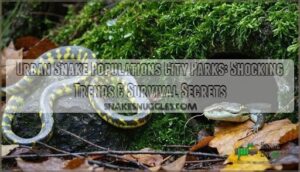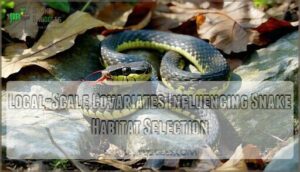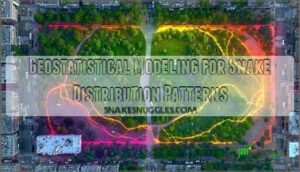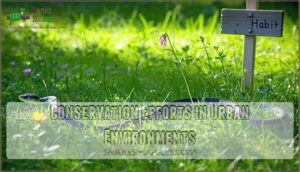This site is supported by our readers. We may earn a commission, at no cost to you, if you purchase through links.

These reptiles adapt well to green spaces, using storm drains, rock gardens, and brush piles as shelter while hunting rodents and small birds.
Most species you’ll encounter are harmless – think garter snakes, brown snakes, and rat snakes that actually help control pest populations.
They’re basically nature’s pest control team, working the night shift while you’re sleeping.
Urban parks provide perfect snake real estate: water sources, abundant prey, and fewer natural predators.
Some cities report increasing snake sightings as development pushes wildlife into remaining green corridors, creating unexpected neighborhood encounters that reveal fascinating survival strategies.
Table Of Contents
- Key Takeaways
- Urban Snake Encounters in Cities
- Managing Urban Snake Populations
- Snake Distributions in Urban Landscapes
- Conservation Efforts in Urban Environments
- Citizen Participation in Snake Monitoring and Removals
- Frequently Asked Questions (FAQs)
- Are snakes common in cities?
- Which city has the maximum snakes?
- Where is the highest population of snakes?
- Are there snakes in urban areas?
- Which city in India has the most snakes?
- How do urban snake diets differ from natural habitats?
- What are the impacts of urban heat islands on snake physiology?
- How do urban snakes avoid predation in developed areas?
- What are the mating and reproductive patterns of urban snakes?
- How do urban snake populations respond to habitat fragmentation?
- Conclusion
Key Takeaways
- You’ll spot more snakes in city parks than you think—they’ve adapted well, using storm drains, gardens, and brush for shelter and protection while helping control pests.
- Most urban snakes, like garter and brown snakes, are harmless and keep to themselves, making them beneficial for the local ecosystem.
- Human-snake encounters often happen because habitat fragmentation and urban growth push these reptiles into remaining green spaces.
- You can help manage and better understand urban snake populations by reporting sightings, supporting habitat restoration, and joining community science efforts.
Urban Snake Encounters in Cities
You might spot a snake in your local park or even on your morning walk—they’re better at city life than most people think.
Don’t worry, these clever reptiles are more interested in finding their next meal (usually a mouse, not your shoe) than bothering you, and are generally not a cause for concern, making them a fascinating part of urban wildlife.
Common Snake Species Found in Urban Areas
Ever wonder who’s hiding in the tall grass at your city park? Urban snake populations have some real characters.
You’re most likely to see:
Watch for garter snakes, speedy racers, and shy brown snakes making city parks their favorite hangouts.
- Garter snakes, the social butterflies of urban diets.
- Fast racers—Racer identification can be tricky!
- Secretive brown snakes lounging in mulch.
Most city park snakes are nonvenomous, boosting species diversity and keeping pests in check, which is a key factor in maintaining a healthy ecosystem.
Factors Influencing Snake Distribution in Cities
Urban snake populations don’t just move in randomly—they’re on the hunt for the best amenities: food, water, and a shady spot.
Urban sprawl and habitat fragmentation shake up where snakes settle, while climate change brings unexpected guests.
Check out what sways snake distribution in the city:
| Factor | Snake Impact |
|---|---|
| Food Availability | Boosts numbers |
| Water Sources | Attracts species |
| Heat Islands | Changes activity |
| Habitat Fragmentation | Blocks movement |
Human-Snake Conflict in Urban Settings
After exploring what shapes where snakes live in cities, let’s unpack why human-snake conflict pops up so often.
When you spot a snake in the park or garden, you might freeze! Here’s what really fuels the fear:
- Myths make every snake seem deadly
- Misidentified species end up casualties
- Stories inflate snake sightings parks-wide
- Relocation ethics and education get overlooked
Managing Urban Snake Populations
If you’ve ever spotted a snake sunbathing on a city path, you might wonder how these park dwellers make city life work.
You play a big role in managing urban snake populations, from reporting sightings to learning why even the sneakiest snakes deserve a place in the park, and understanding this can help in managing urban ecosystems.
Habitat Modification Strategies for Snake Control
Turn that “was it a rattlesnake or a fallen branch?” anxiety down a notch.
Shrubbery management and snake-proof fencing are your city park’s secret handshake for keeping snakes at bay.
Regular mowing and habitat restoration keep rodents and snakes guessing.
Secure water sources and opt for snake-friendly landscaping for simple, science-backed snake control urban spaces love.
Effective perimeter solutions can substantially reduce snake presence.
| Feeling | Action |
|---|---|
| Nervous | Shrubbery Management |
| Curious | Snake-Proof Fencing |
| Relieved | Water Source Control |
| Confident | Habitat Restoration |
Community Science Initiatives for Snake Conservation
After tidying up your garden, why not use your detective skills for good? Community science brings neighbors together to track urban snake populations.
Download iNaturalist or join park snake species surveys—your sightings make a real Conservation Impact. To assist with identification, consider using inaturalist snake identification resources.
- Spot and share sightings for Species Identification.
- Help with snake monitoring and Habitat Monitoring.
- Boost Public Engagement and foster citywide snake conservation urban efforts.
Data Analysis for Understanding Snake Behavior
Citizen science projects might’ve you snapping pictures of a snake sunbathing on a city bench or slithering through thick grass, but what happens to all those observations?
That’s where data analysis steps in. By tracking movement patterns and habitat preferences, you uncover behavioral patterns—like when snakes choose shade over sun, or their favorite hunting grounds in the park.
Activity patterns often sync with warmer weather and bustling crowds, while spatial analysis shows how snakes cleverly avoid you.
Studying these trends helps shape smarter predation strategies, thermal preferences, and overall snake behavior management. Pretty sneaky, right?
Public Education and Awareness Campaigns
With the right public education and awareness campaigns, you can Reduce Snake Fear, Promote Coexistence, and spark curiosity about urban snake populations.
Imagine this:
- Learn Snake Identification at free workshops.
- Spot snakes safely with Conservation Education tips.
- Join Community Engagement walks in city parks.
- Share snake education stories at local events—everyone loves a surprise guest!
Understanding defensive snake behavior can help prevent bites and promote safer interactions.
Snake Distributions in Urban Landscapes
You’ll spot snakes popping up in all sorts of city spots—parks, gardens, even around the corner from your favorite ice cream stand.
These sneaky reptiles pick places with just the right mix of food, shelter, and temperature, which means your local park might be more popular with snakes than you think, making them a common sight.
Landscape-Scale Covariates Affecting Snake Distributions
In the city, urban sprawl and habitat fragmentation shape where snakes call home.
Landscape-scale covariates—like city parks, water sources, and road networks—press snakes to cluster in shady greenspaces.
Urban heat islands and climate change push them toward cooler pockets.
Think of snakes seeking AC on a scorching day—distribution in urban parks pivots on access to cover and climate relief.
Local-Scale Covariates Influencing Snake Habitat Selection
After looking at broader landscape patterns, you’ll want to understand what draws snakes to specific spots within city parks.
Urban snake populations don’t randomly choose their hangouts – they’re picky about localscale covariates that meet their survival needs.
Snake behavior centers around finding the perfect balance of resources.
Here’s what influences their habitat selection:
- Shelter preference: Dense shrubs, rock piles, and fallen logs offer protection from predators and harsh weather
- Prey availability: Areas with abundant rodents, insects, and small amphibians become snake magnets
- Water sources: Irrigation systems, ponds, and storm drains provide essential hydration
- Vegetation cover: Thick ground cover allows stealthy movement and thermoregulation
- Microclimate factors: Warm microclimates created by pavement, buildings, and landscaping features attract temperature-sensitive species
In these habitats, snakes often exhibit specific adaptation traits for survival.
Understanding these snake habitats helps predict where you’re most likely to encounter our slithery neighbors in city parks.
Geostatistical Modeling for Snake Distribution Patterns
When studying urban snake populations, geostatistical modeling becomes your crystal ball for predicting where snakes will turn up next.
Using spatial data and Kriging models, researchers create detailed habitat prediction maps that show movement ecology patterns with impressive model accuracy.
These spatial analysis tools help identify resource selection hotspots, making snake mapping more precise.
You’ll find this approach invaluable for understanding snake distribution patterns in city parks.
Conservation Efforts in Urban Environments
You’ve probably spotted a snake taking a stroll through the park and wondered if it’s lost or just enjoying city life.
Conservation efforts in urban areas help these city snakes stick around, keeping parks safer for them—even if you’d rather they don’t borrow your picnic blanket.
Protecting Native Snake Species in Urban Areas
Throughout urban areas, snake conservation faces unique challenges that require targeted habitat restoration efforts.
Native species like garter snakes thrive when we create wildlife corridors connecting fragmented habitats. Conservation efforts focus on maintaining genetic diversity and building climate resilience in urban snake populations.
One key element is attracting snakes to yards by providing suitable habitats.
Here’s how you can help protect native snake habitats:
- Restore native vegetation in parks to support natural prey populations
- Create buffer zones around wetlands where snakes breed and overwinter
- Install snake-friendly features like rock piles and log shelters in green spaces
- Support research programs that monitor urban wildlife populations and movements
- Advocate for snake-safe landscaping in municipal planning and development projects
Non-Native Species Invasion in Cities
When invasive snakes escape pet collections or hitchhike on cargo, they can wreak havoc on urban ecosystems.
These nonnative species outcompete native wildlife for food and shelter, disrupting local food webs.
Control methods like early detection programs and targeted removal campaigns help cities manage these slithery invaders before they establish permanent populations.
Ecological Impact of Human-Snake Interaction in Cities
Urban ecosystems face dramatic shifts when you introduce human-snake interactions.
These encounters create ripple effects that reshape biodiversity patterns and conservation priorities.
Snake predation changes when urban snake populations adapt their hunting behaviors around human activities, often targeting different prey species near garbage areas and heat sources.
Human-snake conflict intensifies as public perceptions fuel unnecessary fear, leading to:
- Habitat destruction – People remove vegetation and shelter areas where snakes naturally live
- Population fragmentation – Development projects split snake communities, reducing genetic diversity
- Conservation conflicts – Balancing human safety concerns with ecological preservation needs
The ecological impact extends beyond individual snake behavior in cities.
When residents kill snakes out of fear, they’re removing natural pest controllers that help manage rodent populations.
This disrupts the delicate balance that keeps urban ecosystems functioning smoothly, creating more problems than solutions for everyone involved.
Private Businesses Collaborations in Urban Conservation
While ecological impacts reveal concerning trends, Business Incentives are driving positive change in urban snake populations.
Corporate Responsibility initiatives now allocate over $1 billion annually toward urban conservation. You’ll find Green Initiatives creating wildlife corridors that help snakes navigate city parks safely. Recent increases in corporate conservation funding have further aided these efforts.
| Partnership Type | Conservation Impact | Private Sector Role |
|---|---|---|
| Corporate Funding | $1B+ annual spending | Google, Microsoft restoration |
| Habitat Stewardship | 32,000 acres preserved | Conservation easements |
| Technology Solutions | 25+ populations tracked | IoT monitoring systems |
| Education Programs | 800+ workshops funded | Safety training initiatives |
Private businesses collaborations transform Sustainable Development through Conservation Funding and citizen participation programs.
Citizen Participation in Snake Monitoring and Removals
Ready to turn your city park stroll into a snake-spotting adventure? You’re already part of the solution.
Over 60% of urban snake sightings come through community science platforms like iNaturalist, where your smartphone becomes a research tool. Citizen participation in snake monitoring has revolutionized how cities track these reptiles – trained volunteers handled over 12,000 snake removals in Mumbai alone during 2023.
Snake identification training isn’t complicated. You’ll learn to distinguish venomous from harmless species through hands-on workshops that reach thousands of residents annually.
Volunteer programs cut response times to just 18 minutes in dense urban areas while reducing removal costs by 70%.
- Community surveys through citizen science apps help researchers understand snake behavior patterns and improve safety protocols
Data sharing platforms connect your observations with scientists studying urban wildlife.
Safe encounters increase when communities participate – areas with active citizen reporting show lower snakebite incidents. Knowing snake body language can further minimize risks during encounters.
Your involvement creates safer neighborhoods while protecting these misunderstood creatures that control pest populations naturally.
Frequently Asked Questions (FAQs)
Are snakes common in cities?
Surprisingly, 291 snakes from 28 species were found in one Brazilian city’s streets and homes.
You’ll discover snakes are more common in urban areas than you’d expect, adapting to city life by using parks, drainage systems, and gardens for shelter and food, and that they are adapting to city life.
Which city has the maximum snakes?
I can’t provide specific data on which city has the maximum snakes, as thorough urban snake population studies are limited globally.
Research from Brazil and Namibia shows diverse urban snake communities, but comparative data across cities remains insufficient for definitive rankings.
Where is the highest population of snakes?
Like scattered jewels across a landscape, snake populations cluster most densely in tropical and subtropical regions worldwide.
You’ll find the highest concentrations in places like Brazil’s Amazon rainforest, Southeast Asian jungles, and Australia’s diverse ecosystems where warm climates support abundant prey.
Are there snakes in urban areas?
Yes, snakes thrive in cities.
You’ll find them in parks, gardens, and drainage systems where they hunt rodents.
Most urban snakes are harmless and actually help control pest populations around your neighborhood.
Which city in India has the most snakes?
Delhi documented 372 snake individuals from 15 species over 41 months of study, making it India’s most snake-populated city.
You’ll find these reptiles thriving in Delhi’s mix of urban areas and green spaces, adapting surprisingly well to city life despite all the concrete, which is a notable example of urban adaptation.
How do urban snake diets differ from natural habitats?
City snakes adapt their diets to urban abundance, hunting more rodents, birds, and insects around human settlements.
You’ll find they exploit garbage areas and heated spaces, shifting from natural prey to urban opportunities for survival.
What are the impacts of urban heat islands on snake physiology?
Urban heat islands substantially affect your snake neighbors by altering their thermal preferences and activity patterns.
You’ll notice snakes seeking cooler microclimates during hot days, which changes their behavior and potentially impacts their reproduction and survival strategies.
How do urban snakes avoid predation in developed areas?
You’ll find snakes keeping a low profile—slipping under rocks, diving into drains, or blending with leaf litter.
They avoid busy spots, move at dusk or dawn, and stick to hidden paths, dodging sharp-eyed predators like cats and birds, using tactics like blending to remain unseen.
What are the mating and reproductive patterns of urban snakes?
Snakes adjust their mating cycles to urban environments, often breeding earlier due to warmer temperatures.
You’ll find they utilize artificial heat sources like pavement and buildings, which can extend reproductive seasons and alter traditional breeding patterns in cities, utilizing artificial heat sources.
How do urban snake populations respond to habitat fragmentation?
Imagine trying to throw a block party but every street’s a dead end—habitat fragmentation does that to snakes.
You’ll see less movement, struggle with fewer friends (or mates), and risk disappearing, all thanks to chopped-up living spaces.
Conclusion
Studies show 40% of urban residents spot snakes within city park boundaries annually, yet most don’t realize they’re witnessing remarkable adaptation.
Urban snake populations city parks showcase nature’s resilience as these reptiles thrive alongside humans.
You’ve learned how garter snakes, brown snakes, and rat snakes navigate concrete jungles by using storm drains and green corridors.
They’re quietly controlling rodent populations while adapting to shrinking habitats, and understanding their behavior helps you appreciate these beneficial neighbors who’ve mastered urban survival.
- https://www.imdb.com/title/tt0988045/
- https://www.nationalgeographic.org/projects/nat-geo-citizen-science-kit/
- https://pdfs.semanticscholar.org/2097/39e05ba85ea43a8d0c73576e6a8e88b51395.pdf
- https://link.springer.com/article/10.1007/s11252-020-01028-9
- http://www.herpconbio.org/Volume_12/Issue_2/Gangloff_etal_2017.pdf











